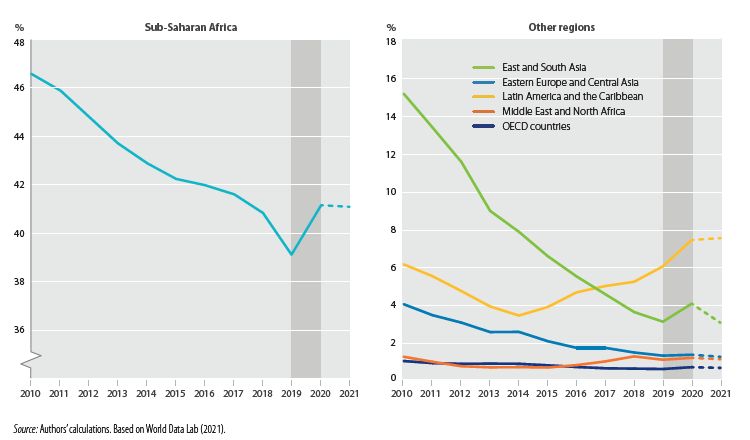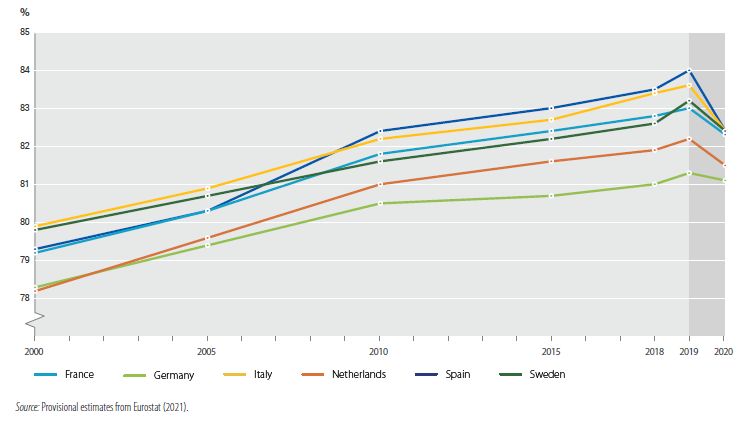The pandemic has been a major setback for sustainable development everywhere. There is a very real risk that inequalities will widen greatly between rich and poor countries due to differences in access to vaccines and financing, says The United Nations Sustainable Development Report 2021. The health and economic rationales for a rapid global scaling-up of vaccinations are clear, even more so with the emergence of new variants like Omicron and Delmicron. The COVID-19 pandemic has impacted all three dimensions of sustainable development: economic, social, and environmental.
SDG 1: No Poverty
After several years of significant reduction, extreme poverty increased in 2020 in sub-Saharan Africa and in other parts of the world. The pandemic has pushed an estimated 120 million people into extreme poverty over the past year (defined as living on less than $1.90 a day), mostly in low- and middle-income countries. The pandemic has also impacted access to food and increased food insecurity covered under SDG 2 (Zero Hunger), while the slowdown of economic activity and the global recession saw significant increases in unemployment in 2020, impacting SDG 8 (Decent Work and Economic Growth).

SDG 3: Good Health and Well-Being
The pandemic has caused decreases in life expectancy, including in high-income countries such as those in Europe. COVID-19 mortality rates and declines in life expectancy are greater among the most vulnerable groups, the poor, and marginalized communities.

In the United States, life expectancy declined by one full year on average but by 2.7 years for Black Americans and 1.9 years for Hispanics. COVID-19 also impacted well-being and self-reported feelings of depression and anxiety in many countries and some COVID-19 survivors may experience long-term mental health effects.
SDGs 4, 5, 6, 7, and 9
The pandemic has affected countries and people in very different ways, making the SDG principle of Leaving No One Behind particularly relevant in emergency responses and recovery plans. The pandemic has had a negative impact on progress towards SDG 4 (Quality Education) and SDG 5 (Gender Equality), and on access to key infrastructure, including water and sanitation, covered under SDG 6 (Clean Water and Sanitation), SDG 7 (Affordable and Clean Energy), and SDG 9 (Industry, Innovation and Infrastructure).
School closures, which lasted for several months in many parts of the world have immediate short-term impacts on children’s mental health and possibly also longer-term impacts on student learning and education systems. This is especially true for countries and among populations with limited access to digital infrastructure like India, where school closures could not be partially compensated by remote learning. The health and socioeconomic impacts were amplified for people living in slums or deprived areas, or in overcrowded settlements (SDG 11).
SDGs 12, 13, 14 and 15
In parallel, billionaires increased their wealth by more than a quarter (27.5%) from April to July 2020. Temporary gains observed on SDGs 12 to 15 over the past year related to sustainable production and consumption, climate action and biodiversity protection have been rapidly offset once restrictions were lifted. This applies to CO₂ emissions, which declined in major economies during the strict lockdowns, including in China and the United States, but went quickly back to their pre-pandemic levels after restrictions were lifted. Deforestation is estimated to have increased by 12% from 2019 to 2020 and plastic consumption and waste may also have grown during the pandemic. Yet an increased number of bold commitments made over 2020 towards achieving climate neutrality by mid-century (or 2060) – including pledges made at the Leaders Summit on Climate in April 2021 and in many G20 countries – might provide the needed momentum for accelerated action on the climate and biodiversity goals.
SDGs 16 and 17
Finally, the functioning of political systems, the rule of law, and multilateralism have also been challenged during the pandemic. These are covered under SDG 16 (Peace, Justice and Strong Institutions) and SDG 17 (Partnerships for the Goals). Many reforms were postponed during the pandemic, while some emergency directives and regulations were taken without the usual deliberative processes. The multilateral system showed some signs of fracturing, characterized notably by the global gap in access to vaccines and the emergence of “vaccine nationalism”.

